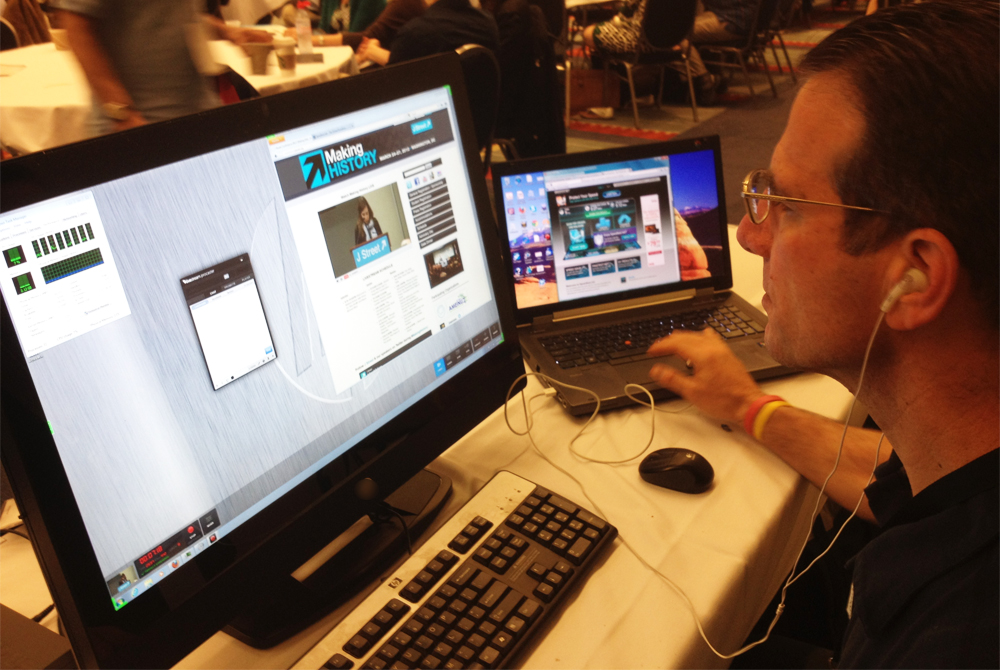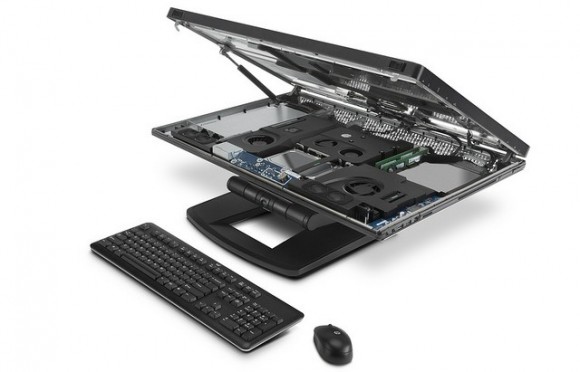This is the unofficial third segment in a multiple-part series on webcasting JStreet.org[http://jstreet.org]’s national convention. In this segment, I’ll focus on the computer I used to webcast the conference, HP’s new Z1 workstation, shown in Figure 1 (below). The computer was so new that at the time of the conference, it was still not formally released (its official release date is April 16), perhaps making the JStreet webcast the first time the Z1 was actually used in a production event.

Contents
Figure 1. The HP Z1 all-in-one workstation.
I thought about leaving the Z1 in a bar in Georgetown, a la the famous iPhone prototype, but it’s a bit too big to carry around and well past the prototype phase. Besides, after working with the Z1 even for a couple of weeks, the last thing you want to do is leave it anywhere. But I get ahead of myself.
Birth of a Beauty
The Z1 is HP’s first all-in-one workstation with a huge 27″ display that dwarfs the 17″ notebook you can see on its right in Figure 1. Why an all-in-one workstation? Primarily for the size; HP saw a need for a workstation-class product that could fit into the shrinking spaces inhabited by the creative, design, and financial executives who buy a good share of HP’s traditional workstations.
Significantly, the Z1 is the first all-in-one computer with workstation components and field serviceability. Like the fabulous Z200, Z400, Z600, and Z800 workstations, you can open the case and change most components without any tools (Figure 2, below). According to the HP officials who briefed me on the product, field serviceability was a key product requirement, since their professional customers didn’t want a product they would have to return to swap out a failed optical drive, power supply, or graphics card.

Figure 2. The Z1 is completely field serviceable with tool-less entry and component switching
The other key requirement was workstation-class components and third-party product certifications. The Z1 uses the same processor, chipset and memory as the Z200 workstation, including 1600 Mhz memory, which is the fastest available. For the CPU, you can choose either a dual-core Intel Core or quad-core Intel Xeon CPU with speeds up to 3.5 GHz, and memory configurations of up to 32 GB. For graphics, you have your choice of four NVIDIA Quadro cards, the 500M, 1000M, 3000M and 4000M, with an extra display port for either driving a second monitor or having the Z1 function as a second monitor for another computer.
The unit also features SRS premium sound and front-facing speakers, rather than the downward-facing speakers found on many other all-in-ones. And the HD webcam is simply the most impressive one I’ve seen to date, simply amazing clarity. If you’re looking for a luxury ride for your video Skype or Oovoo chats, the Z1 should definitely be in the running.
As you can see in Figure 2 on the previous page, the unit folds down to the stand and locks there for easy lifting, or as easy as a unit that weighs in at about 50 pounds can be. Press a button on the front of the stand and you unlock the mechanism, so you can unfold the stand and swivel the monitor forward and back, for nearly unlimited height and positioning adjustments.
For the record, my Z1 came with the 3.5 GHz Xeon with 16 GB of memory and the Quadro 4000m running Windows 7. The 30-bit display is absolutely gorgeous, and looks bigger than the 31″ displays in my office. The first time my younger (and more technical) daughter saw it, she ooed and ahhed and asked, “Where’s the computer?” I don’t think she believed that it was an all-in-one until I opened up the case and showed her what was inside.
It’s one thing to have workstation specs; it’s quite another to deliver workstation performance. So I was eager to learn how the Z1 would perform against its quite accomplished older siblings. So let’s have a look at that and then circle back to my JStreet experience.
Performance Results
My tests focused in three areas: Adobe CS5.5 rendering (results in Table 1, below), streaming encoding, and live encoding. In the first two I compared the Z1 to a single core Z400 workstation, the third I just measured standalone performance. To set the stage, the Z400 was configured with a 2.67 GHz 4-core Xeon, along with 24 GB of memory and a Quadro 2000M graphics card.

Table 1. CS 5.5 rendering performance.
To briefly detail the projects, the Nutcracker is a dual-camera HDV shoot, where I rendered out the first ten minutes to DVD-compatible MPEG-2 and 720p H.264. The Beth project is a single-camera DSLR shoot where I rendered out the first ten minutes to the same two formats. Laura is a single-camera AVCHD shoot with the first ten minutes again rendered to the same two outputs.
In assessing performance, remember that two aspects of product configuration should impact performance. First, the Z400’s CPU was 24% slower, which should impact rendering performance relatively linearly. However, the Z400 proved at least 40% slower than the Z1 in these rendering tests, with some tests extending to 51%.
The other component affecting performance is the graphics card, which Premiere Pro uses to help render in its Mercury engine. Here, the Z1’s Quadro 4000M is definitely faster than the 2000M in the Z400, though the differences are not linear. In fact, I ran the same rendering tests on the Z400 with the $1,600 Quadro 5000 installed, and the Z1 was still more than 31% faster in four of six tests. Any way you slice it, the Z1 performs very well against traditional single-CPU workstations in rendering performance.
Streaming Encoding
Next I tested both Sorenson Squeeze 8 ($799) and Telestream Episode Engine ($3,995). With Squeeze, I applied two adaptive bitrate presets to a 4:50 (min:sec) 1080p source file, with each preset comprising six output files each, plus post-processing to create the chunked file structure and metadata files required by the two formats. I ran Squeeze configured to encode eight files simultaneously, and disabled GPU- acceleration (results in Table 2, below).

Table 2. Streaming encoding testing.
With Episode, I encoded the same source file to eleven different H.264 outputs with no post-processing, running four simultaneous encodes. The Squeeze and Episode tests were completely different, so you shouldn’t draw any conclusions regarding their respective performance from these tests. Just note that in each case, the Z1 bested the Z400 by more than the 24% difference in CPU speed.
Next, I loaded Telestream Wirecast on the Z1, connected a DV camera and selected four 16×9 presets to stream to disk simultaneously, simulating a live event broadcast pushing out four separate streams. CPU utilization ranged from 40-45%, leaving plenty of overhead for additional streams or HD streams. Then I loaded the Adobe Flash Live Media Encoder, created three output streams which I stored to disk, and started streaming. Here, CPU utilization averaged 25-30%, again, leaving pretty of headroom for additional or larger streams.
Overall, the Z1 performed the same or better than its traditional-form-factor sibling, proving out HP’s claim that it is a workstation-class device.
Live Streaming with the Z1
The Z1 is big, beautiful and bold, but it’s also not light, with the lightest configuration weighing in at 47 pounds. It’s the kind of machine that you’ll adore having at your webcast or tradeshow, but getting it there and set up could be a problem if you haven’t had your Wheaties. On the other hand, unlike notebooks, the Z1 can’t easily walk away on its own accord, so you’re a little more comfortable leaving it for a quick trip to the loo or for coffee.
The other issue is expandability: There are no free internal slots. In my webcast, I connected an old Canopus AVDC300 FireWire converter to the Z1’s FireWire port, which worked fine for SD input. There are also 2 USB 3.0 slots and 4 USB 2.0 slots, providing the necessary connectivity for multiple third-party options for any connection from analog to HD-SDI. Still, to use the Z1 as a live encoding station, you’ll have to plan for external connectivity.
These considerations aside, it was fabulous working with the Z1 at the J Street event. Conventional wisdom says that you should have a separate computer available for monitoring the live stream; hence the HP Elitebook 8760w to my right in Figure 1. However, the public Wi-Fi at the convention center averaged about 70 Kbps, so my only option was to encode and play back on the same computer using the event’s dedicated connection. I never noticed CPU utilization exceeding 20% for single-file encoding and streaming playback, which is fine in my book; I’d rather have too much power than too little.
Overall, I see the Z1 as a killer solution where space is tight and where you need workstation class performance in a transportable form factor. Now that tablets and smartphones are starting to replace notebooks, I also see it as a great home base for professionals who want to work on a powerful big-screen computer while at their offices, and don’t need a notebook when they travel.
 Streaming Learning Center Where Streaming Professionals Learn to Excel
Streaming Learning Center Where Streaming Professionals Learn to Excel








